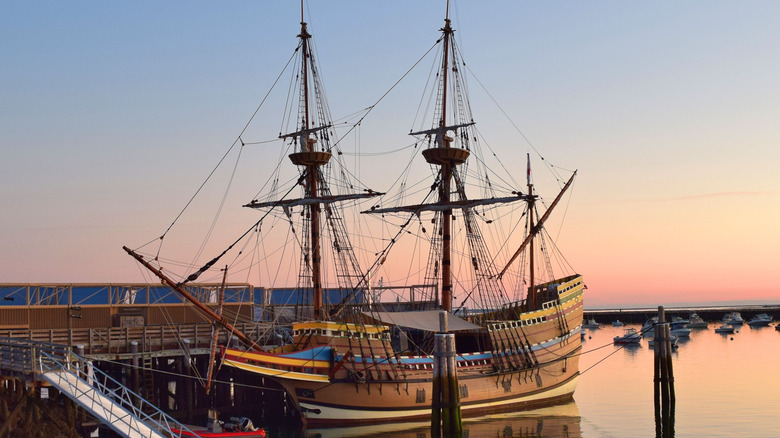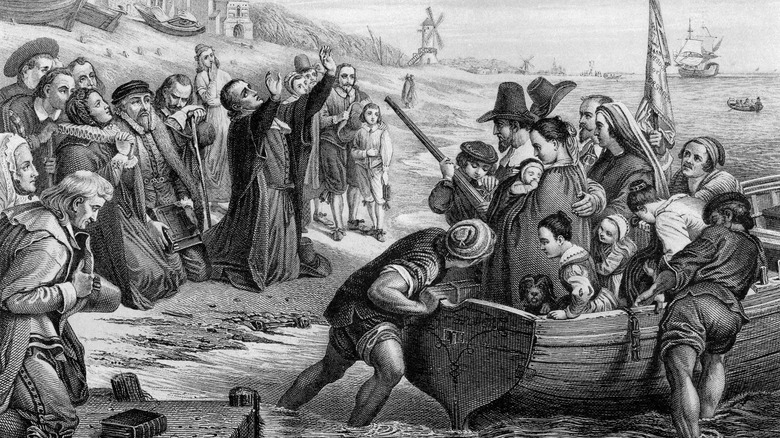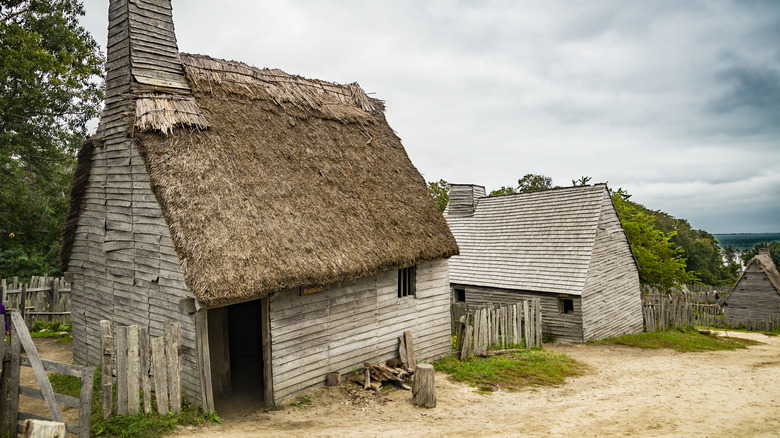This Is How Many People Were On The Mayflower When It Came To America
Ah, the Pilgrims: Those funny-hated people on a cross-oceanic pilgrimage who were really into the Bible, stubbed their toes on Plymouth Rock when daringly stepping forth onto Native lands, and then shot a turkey with a musket to inaugurate Thanksgiving. Does that about cover the story? Sure, details have gotten hazy over the centuries, and American self-mythologizing often eclipses historical facts, but one thing's for sure: Those Pilgrims definitely did not have a good time on their boat, the Mayflower — not with one person on board per foot of ship length.
Yes, things were a bit cramped and grim on that intrepid voyage to the "New World" in 1620. As History recounts, the 102 Pilgrims and 37 crew who formed Plymouth Colony in modern-day Massachusetts kicked off from the Dutch port of Delfshaven with nothing but a 100-foot-long boat with 5-foot-high ceilings, terrible weather ahead, and a whole lot of beer on board. Amongst the ship's three decks and different sections was a meager 58-by-24-foot space available for all 102 passengers (the crew apparently stayed separate).
Amazingly so, as History continues, only one person — just one — died during the two-month horror across the Atlantic, and then only a few days before reaching the Pilgrims' new home. Others came close, like one hapless dude who just wanted a breath of fresh air and got blown into the ocean. But in the end, 139 people got on board the Mayflower, and 138 stepped off.
Much worse than flying coach
Even before the 102 Pilgrims and their ship's cooks, sailors, doctors, etc., shipped off from Holland in 1620, they hadn't been having a good time. They'd broken off from the Church of England — formed less than 100 years prior in 1534 — to practice their beliefs as they wished. As the Pilgrim Hall Museum says, Pilgrim and eventual Plymouth governor William Bradford openly derided the Church of England's "colours & pretences" as standing in opposite to the "ye simplicitie of ye gospell" and castigated the church for the "lordly & tyranous power" it employed in persecuting the Pilgrims. So, the Pilgrims left England for the more religiously tolerant Netherlands, arrived in Amsterdam, and then in 1609 moved to the quaint town of Leiden before setting out across the ocean a decade later.
In what must have certainly seemed to the ultra-pious Pilgrims a "test of faith," conditions on the Mayflower were miserable. Those on board comprised a single Separatist church congregation from Scrooby, England, and only became "Pilgrims" after having set out on their pilgrimage. As History says, these 102 Scrooby congregants would have run out of fresh food in days and then turned to preserved goods like dried fish, salted pork, and hard bread. Folks went hungry, drank beer for nourishment — even children — and seasickness abounded as the ship got swept off course again and again. But as stated, only one person died on the 66-day journey.
Far deadlier than the ocean
Unfortunately for the 101 Pilgrims and 37 crew who arrived in Cape Cod, they wound up landing at an awful time of the year: November. As History recounts, things went from bad to worse in those initial weeks as they had to build an entire self-sustaining settlement from the ground up at the onset of a New England winter. And while only one person didn't make the voyage despite the terrible travel and living conditions, half of those who landed in Massachusetts died before the following spring. And yet, in fortuitously symbolic fashion, the colony's first baby survived the winter. As World History Encyclopedia says, thousands more Europeans seeking a place of religious tolerance joined the Pilgrims in the following decades, and the Pilgrim's original settlement — Plymouth Colony — survived and thrived.
By all accounts, it was aforementioned Scrooby leader William Bradford who retained his leadership role aboard the Mayflower before becoming governor of Plymouth Colony. He's also where we get much of the information about the Pilgrims' journey in the form of his writings. He described a leaky, creaky ship battered by wind and waves that mirrored the damaged morale of its passengers. True to form, however, the hardy Pilgrims rallied and fixed the damages, same as they propped up their own spirits. This attitude alone might account for why such a small group of people formed such a critical part of American history.


